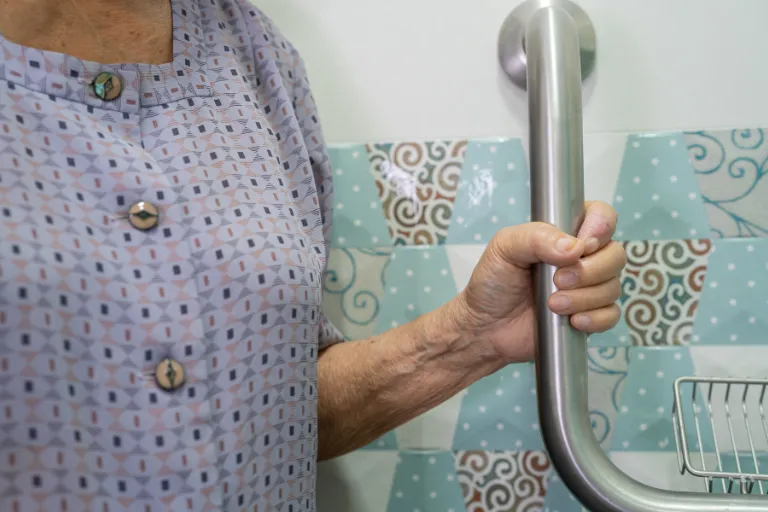Key Points
- Bathrooms are one of the most dangerous places for seniors, with slippery floors and limited support increasing fall risk.
- Simple, affordable changes—grab bars, non-slip mats, shower chairs, and better lighting—can dramatically improve safety.
- These modifications not only protect physical health but also promote dignity, independence, and peace of mind.
- Evidence-based safety measures are supported by aging-in-place experts, occupational therapists, and health organizations.
Why Bathroom Safety Is a Hidden but Urgent Issue
Every year, millions of older adults experience a fall—and many of these incidents happen in the bathroom. According to the Centers for Disease Control and Prevention (CDC), roughly one in four Americans over age 65 falls each year, and the bathroom is among the most common sites due to hard, slippery surfaces [1]. What seems like a simple shower can quickly become a dangerous task, with serious consequences for health, mobility, and independence.
These falls are not only physically damaging but also emotionally disruptive. Research shows that after a fall, many seniors experience heightened fear, reduced activity, and loss of confidence in daily routines [2]. The good news is that simple, evidence-based modifications can dramatically reduce risks while preserving the sense of autonomy that is so vital for healthy aging.
The Importance of Bathroom Safety for Healthy Aging
For seniors, the bathroom represents more than hygiene—it’s a space of privacy and autonomy. Yet, it also poses unique challenges. Wet floors, tight spaces, and the need to maneuver in and out of tubs or showers make it a high-risk environment.
Beyond physical injuries, the fear of falling often lingers long after a close call. Some older adults begin avoiding bathing altogether, which can lead to hygiene issues, skin infections, and even social isolation [3]. By proactively addressing these risks, families can protect health, reduce stress, and support older adults in maintaining dignity and independence.
Why Bathrooms Pose High Risks for Seniors
Falls in the bathroom are more than an inconvenience—they can have life-altering consequences. Broken hips, head injuries, or lengthy recovery times are common outcomes. Even when hospitalization isn’t required, seniors often report that the fear of falling reduces their quality of life and leads to increased dependence on others [4].
Caregivers, too, face stress when bathroom safety is overlooked. The constant worry about a loved one slipping while bathing can create anxiety for families, highlighting the urgent need for preventive measures.
Understanding the Science of Bathroom Fall Risks
Age-related changes—such as reduced muscle strength, slower reflexes, and balance difficulties—make seniors particularly vulnerable in wet, slippery environments. Studies show that moisture, smooth tiles, and sudden movements (like stepping out of a tub) multiply fall risk [5]. Medications for blood pressure or heart palpitations can also cause dizziness, further increasing danger.
The bathroom’s hard surfaces amplify these risks: unlike a bedroom or living room, there is little to cushion a fall. That’s why organizations like the National Institute on Aging emphasize even modest home modifications as powerful tools for prevention [6].
Practical Strategies: Simple Modifications That Make a Big Difference
Evidence shows that small, low-cost changes can reduce fall risk by up to 50% when consistently applied [7]. Below are the most effective interventions, endorsed by health organizations and aging-in-place experts.
1. Install Grab Bars and Handrails
- Place grab bars near toilets, bathtubs, and showers for stability.
- Use ADA-compliant, textured designs that are easier to grip with wet hands.
- Studies confirm grab bars significantly reduce the likelihood of bathroom-related falls [8].
2. Use Non-Slip Mats and Slip-Resistant Flooring
- Add rubberized mats inside and outside the shower or tub.
- Long-term upgrades like slip-resistant flooring are effective but also affordable compared to medical costs from falls.
3. Add Shower Chairs and Handheld Showerheads
- Shower chairs reduce fatigue and instability, offering seated bathing comfort.
- A handheld showerhead increases flexibility and reduces awkward movements that can trigger slips.
4. Improve Bathroom Lighting and Visibility
- Bright, glare-free lighting makes a significant difference for seniors with vision decline.
- Motion-sensor lights add safety for nighttime bathroom trips.
5. Raise Toilet Seats and Add Support Frames
- Elevated seats reduce strain on knees and hips, while side frames provide balance.
- Occupational therapists often recommend this as a first-line modification for users with joint pain.
6. Explore Innovative Safety Tools
- Motion-sensor faucets, anti-scald devices, and even fall-detection wearables are increasingly integrated into senior care strategies.
- These innovations add layers of safety while enhancing confidence for both seniors and caregivers.
Together, these modifications not only protect physical health but also provide emotional reassurance, making the bathroom a safer, more welcoming space for daily routines.
Next Steps: How Families Can Begin Today
Improving bathroom safety doesn’t require a full remodel. Start by walking through the bathroom with a loved one to identify hazards: Is the floor slippery? Is lighting dim? Is there something sturdy to hold onto when getting in or out of the shower? Simple additions like grab bars and non-slip mats can often be installed in less than a day.
Families unsure where to begin can consult a health professional or aging-in-place specialist for tailored advice. Trusted organizations like AARP provide detailed home safety checklists, offering a roadmap for safe, independent living [3].
Conclusion
Falls don’t have to be an inevitable part of aging. By making simple yet powerful modifications, families can transform bathrooms into spaces that support safety, comfort, and independence. These changes go beyond preventing injury—they preserve dignity, reduce fear, and help seniors continue enjoying life’s daily routines with confidence.
The question isn’t whether we can afford to make these modifications—it’s whether we can afford not to.
The article does not in any way constitute as medical advice. Please seek consultation with a licensed medical professional before starting any treatment. This website may receive commissions from the links or products mentioned in this article.
Subscribe for Free for more insightful health articles tailored to your needs.
Sources
- Centers for Disease Control and Prevention. (2023). Important facts about falls. https://www.cdc.gov/falls/facts.html
- Clemson, L., Mackenzie, L., Ballinger, C., Close, J., & Cumming, R. G. (2008). Environmental interventions to prevent falls in community-dwelling older people: A meta-analysis of randomized trials. Journal of Aging and Health, 20(8), 954–971. https://doi.org/10.1177/0898264308324672
- AARP. (2024). HomeFit Guide: Smart solutions for making a home comfortable, safe, and a great fit. https://www.aarp.org/livable-communities/housing/info-2024/homefit-guide.html
- Stevens, J. A., & Burns, E. R. (2015). A CDC Compendium of Effective Fall Interventions. CDC Injury Center. https://www.cdc.gov/homeandrecreationalsafety/falls/compendium.html
- Lord, S. R., Sherrington, C., Menz, H. B., & Close, J. C. T. (2007). Falls in Older People: Risk Factors and Strategies for Prevention. Cambridge University Press.
- National Institute on Aging. (2022). Falls and fractures in older adults: Causes and prevention. https://www.nia.nih.gov/health/falls-and-fractures-older-adults-causes-and-prevention
- Pighills, A. C., Ballinger, C., Pickering, R. M., Chari, S., & Roberts, H. C. (2011). A critical review of the effectiveness of environmental assessment and modification in the prevention of falls. European Review of Aging and Physical Activity, 8(1), 13–22. https://doi.org/10.1007/s11556-010-0073-0
- La Grow, S., Robertson, M. C., Campbell, A. J., Clarke, G. A., & Kerse, N. M. (2006). Reducing hazard-related falls in older home care clients: A randomized controlled trial. Age and Ageing, 35(4), 392–397. https://doi.org/10.1093/ageing/afl005
Last Updated on September 24, 2025



